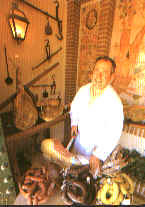
Rute
The village of Rute, on the southern fringe of the
Sierra Subbeticas Nature
Park in Cordoba, is a place of pilgrimage for anyone interested in Andalucian gastronomy. The
town is well known for its sweet pastries, its nougat candy, its sausages
and hams, and particularly for its anis liqueur.
 Sweet or dry, this aniseed-flavored spirit
is something of a national beverage in Spain, consumed especially around
Christmas to accompany Yuletide sweets, and Rute as been a major producer
since the mid-17th century. Formerly, it was made with orujo, or
marc, distilled from the mash of grape skins left over from wine
making. When the phylloxera (vine route louse) plague that swept
through Europe in the 19th century wiped out the local vineyards, the
distillers switched to rectified cane spirits. For the classic Rute
anise, this is distilled with aniseed in a still fuelled by olive
wood. More recent variations include fruit liqueurs flavored with
apples, pears, cherries or herbs, which are left to macerate with the
spirits in large clay jars.
Sweet or dry, this aniseed-flavored spirit
is something of a national beverage in Spain, consumed especially around
Christmas to accompany Yuletide sweets, and Rute as been a major producer
since the mid-17th century. Formerly, it was made with orujo, or
marc, distilled from the mash of grape skins left over from wine
making. When the phylloxera (vine route louse) plague that swept
through Europe in the 19th century wiped out the local vineyards, the
distillers switched to rectified cane spirits. For the classic Rute
anise, this is distilled with aniseed in a still fuelled by olive
wood. More recent variations include fruit liqueurs flavored with
apples, pears, cherries or herbs, which are left to macerate with the
spirits in large clay jars.
It wasn’t long before someone thought of
opening a museum to honor the town’s famous tipple. The Duende
distillery, founded in 1908 and one of eight currently existing in town,
 opened its Museo del Anis in 1995, with
displays devoted to the hundred-odd firms that have been devoted to making
anise in Rute over the centuries. Visitors learn about the process,
at the heart of which is a copper still of classic design, and get to
sample the local firewater in its various permutations.
opened its Museo del Anis in 1995, with
displays devoted to the hundred-odd firms that have been devoted to making
anise in Rute over the centuries. Visitors learn about the process,
at the heart of which is a copper still of classic design, and get to
sample the local firewater in its various permutations.
After a stop at the Museo del Anis, visitors can move on to the recently-opened Museum of Ham nearby. There they are greeted by a plaque with the words of the writer Miguel Cervantes, who in one of his stories prescribes the hams of Rute as an excellent cure-all. The museum is run by the brothers Jimenez, and aside from displaying the craft of ham curing and sausage making it is a tribute to their father, Pablo Jimenez. Though now retired after 60 years as butcher and sausage maker, he is usually on hand to recount how he would travel miles on foot to purchase the finest porkers for his shop.
Antequera | El Torcal | El Chorro | Alora | Carratraca | Alhambra Palace | Rute
© Iznajar Villas 2003-2005
Home | Villas | Local Area | History | Contact Us | Travel Links | Advertise